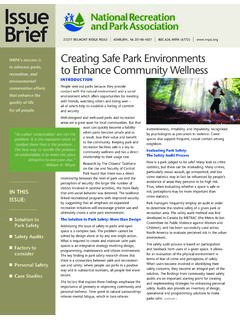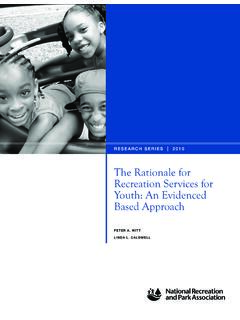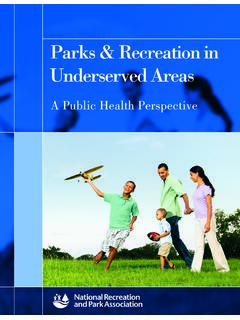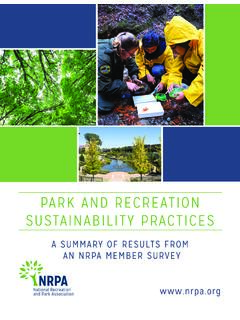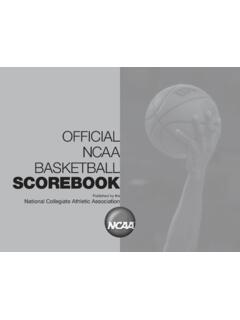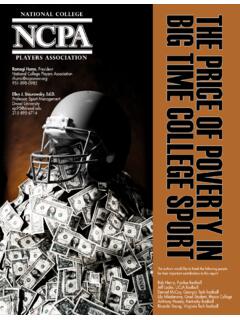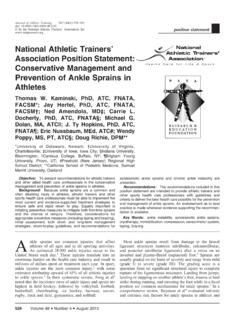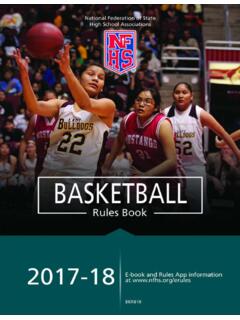Transcription of PARK AND RECREATION AGENCY PERFORMANCE …
1 2020 2020 NRPA AGENCY PERFORMANCE REVIEWBECAUSEEVERYONE DESERVESA GREAT PARKCONTENTE xecutive SummaryAgency PERFORMANCE review InfographicIndex of FiguresKey FindingsPark FacilitiesProgrammingResponsibilities of Park and RECREATION AgenciesStaffingBudgetAgency FundingPolicies Additional NRPA ResourcesConclusionsAbout NRPA04050608111416182225 2629314 national RECREATION AND PARK ASSOCIATIONEXECUTIVE SUMMARYPark and RECREATION professionals work tirelessly to enhance the quality of life for all people in every city, town and county in the United States. Thanks to the contributions of more than 160,000 full-time park and RECREATION professionals along with hundreds of thousands of part-time and seasonal workers and volunteers millions of people benefit directly from the services parks and RECREATION provides. Those services range from gathering places to meet with friends and family to open spaces to exercise, the chance to reconnect with nature to community resources offering a nutritious meal or an opportunity to learn a new skill.
2 The national RECREATION and Park association (NRPA) is pleased to present this snapshot of local park and RECREATION professionals and their agencies: the 2020 NRPA AGENCY PERFORMANCE review . The report summarizes the key findings from the national RECREATION and Park association s NRPA Park Metrics, our benchmarking tool that assists park and RECREATION professionals in the effective management and planning of their operating resources and capital facilities. Taken together, the 2020 NRPA AGENCY PERFORMANCE review and NRPA Park Metrics represent the most comprehensive collection of park- and RECREATION -related benchmarks and insights that inform professionals, key stakeholders and the public about the state of the park and RECREATION is a powerful tool, but not the final answer for what is best for your AGENCY . The 2020 NRPA AGENCY PERFORMANCE review and NRPA Park Metrics help inform conversations with internal colleagues, external consultants, partners and policymakers about the role of parks and RECREATION in your community.
3 The combination of insights from this report with information about your community s specific needs and experiences will help identify the optimal mix of facilities and programming your AGENCY should 2020 NRPA AGENCY PERFORMANCE review does not include national standards, nor do the benchmarks represent any sort of standards against which every park and RECREATION AGENCY should measure itself. The reason for this is simple: there is not a single set of standards for parks and RECREATION because different agencies serve different communities that have unique needs, desires and challenges. Agencies also have diverse funding mechanisms. For instance, if your AGENCY has more workers per 10,000 residents relative to the typical AGENCY , you should not necessarily shed staff to meet that benchmark. An AGENCY with a larger staff may offer more hands-on programming because of the unique needs of the population it serves. Communities vary in population demographics; so too should their park and RECREATION agencies.
4 Successful agencies tailor their offerings to meet the needs and demands of all members of their communities. Knowing the characteristics of the residents who use your AGENCY s resources as well as the characteristics of those who may use those resources in the future (including age, race and income trends) is also a factor when shaping the optimal mix of facilities and services your AGENCY offers. Park and RECREATION professionals should use the 2020 NRPA AGENCY PERFORMANCE review in conjunction with other resources, including those that may be proprietary to a specific AGENCY , those from NRPA and others from external sources. This report also provides a list of additional NRPA resources to TO USE THE 2020 NRPA AGENCY PERFORMANCE review AND NRPA PARK METRICSThe first step is to look at the available data. Most of the data in the 2020 NRPA AGENCY PERFORMANCE review are presented with medians along with data responses at the lower quartile (lowest 25 percent) and upper quartile (highest 25 percent).
5 The data allow for insights into not only where your AGENCY stands compared to typical agencies ( , those at the median values), but also compared to the full spectrum of agencies at both the high and low quartiles. Many metrics include the top-line figures, as well as certain cross-tabulations of jurisdiction population or population density. More comprehensive cross-tabulations are available as interactive tables at next step is to build a customized benchmark report based on a peer group you define. Go into NRPA Park Metrics to filter the data by AGENCY type, size and geographic region. You can enhance this experience even further by entering your AGENCY s data into NRPA Park Metrics, after which you can generate reports that compare your AGENCY s data with the key metrics of agencies throughout the United 2020 NRPA AGENCY PERFORMANCE review contains data from 1,053 unique park and RECREATION agencies across the United States, as reported between 2017 and 2019.
6 Note: Not all agencies answered every survey NRPA AGENCY PERFORMANCE review Key FindingsAgencies that ban the use of tobacco products at parks and facilities76%Full-Time Equivalent Employees (FTES) Per 10,000 Residents:8 .1 Operating Expenditures Per Capita:$ park and RECREATION agencies offer themed special events to the publicManages miles of walking, hiking, running and biking trails88%Revenue-to- Per Park:2,281of park and RECREATION agencies deliver STEM programming to children and young adults54%6 national RECREATION AND PARK ASSOCIATIONThe 2020 NRPA AGENCY PERFORMANCE review highlights characteristics of America s local public park agencies with graphics categorized into seven sections: park facilities, programming, responsibilities of park and RECREATION agencies, staffing, budget, AGENCY funding and FINDINGPAGE FACILITIESF igure 1: Residents per ParkThere is typically one park for every 2,281 2: Acres of Parkland per 1,000 ResidentsThe typical park and RECREATION AGENCY has acres of parkland for every 1,000 residents in the 3.
7 Outdoor Park and RECREATION Facilities Prevalence and Population per FacilityAn overwhelming majority of park and RECREATION agencies have playgrounds ( percent) and basketball courts ( percent) in their portfolio of outdoor 4: Miles of TrailThe typical park and RECREATION AGENCY manages or maintains 11 miles of trails for walking, hiking, running and/or 5: Indoor Park and RECREATION Facilities Prevalence and Population per FacilityA majority of agencies offer community centers and RECREATION centers; two in five agencies offer senior 6: Programming Offered by Park and RECREATION AgenciesKey programming activities include themed special events, team sports, social RECREATION events, fitness enhancement classes, and health and wellness 7: Targeted Programs for Children, Seniors and People with Disabilities83 percent of agencies offer summer camp for their communities younger OF PARK AND RECREATION AGENCIESF igure 8: Key Responsibilities of Park and RECREATION AgenciesTop roles include operating and maintaining parks and indoor facilities, providing RECREATION programming and services, and conducting jurisdiction-wide special 9: Other Responsibilities of Park and RECREATION AgenciesOperating, maintaining or contracting golf courses or tourism attractions and managing large PERFORMANCE outdoor amphitheaters lead the list of other AGENCY 10.
8 Park and RECREATION AGENCY StaffingThe typical park and RECREATION AGENCY has a payroll of full-time equivalent staff (FTEs).16 Figure 11: Park and RECREATION FTEs per 10,000 ResidentsThe typical park and RECREATION AGENCY has FTEs on staff for each 10,000 residents in the jurisdiction served by the 12: Responsibilities of Park and RECREATION WorkersOperations and maintenance, programming and administration are the main responsibilities of park and RECREATION OF FIGURES2020 NRPA AGENCY PERFORMANCE REVIEW7 BUDGETF igure 13: Annual Operating ExpendituresThe typical park and RECREATION AGENCY has annual operating expenditures of $4,342, 14: Operating Expenditures per CapitaThe typical park and RECREATION AGENCY has annual operating expenses of $ on a per capita 15: Operating Expenditures per Acre of Park and Non-Park SitesThe median level of operating expenditures is $7,160 per acre of park and non-park sites managed by the 16: Operating Expenditures per FTEThe typical park and RECREATION AGENCY spends $97,093 in annual operating expenditures for each 17.
9 Distribution of Operating ExpendituresAt the typical park and RECREATION AGENCY , staffing costs account for 54 percent of the operating 18: Operating Expenditures Dedicated to Parks or RecreationThe typical park and RECREATION AGENCY dedicates 44 percent of its operating budget to park management and maintenance and 43 percent to FUNDINGF igure 19: Sources of Operating ExpendituresPark and RECREATION agencies derive 60 percent of their operating expenditures from general fund tax 20: Park and RECREATION Revenues per CapitaThe typical park and RECREATION AGENCY generates $ in revenue annually for each resident in the 21: Revenue as a Percentage of Operating Expenditures (Cost Recovery)The typical AGENCY recovers percent of its operating expenditures from non-tax 22: Five-Year Capital Budget SpendingPark and RECREATION agencies spend a median of $5,000,000 in capital expenditures budgeted over the next five 23: Targets for Capital ExpendituresOn average, just over half of the capital budget is designated for renovation, while 32 percent is geared toward new 24: Park and RECREATION AGENCY PoliciesThree-quarters of park and RECREATION agencies ban the use of tobacco products at most/all of their parks and RECREATION AND PARK ASSOCIATIONL ocal and regional park and RECREATION agencies vary greatly in size and the types of facilities they offer.
10 The typical AGENCY participating in NRPA Park Metrics serves a jurisdiction a town, city, county and/or region of 42,428 people. Other agencies serve an area of just a few thousand people; still others are the primary RECREATION resource for millions of , the offerings of these agencies are as varied as the markets they serve. The typical park and RECREATION AGENCY manages 20 parks comprising a total of acres. After adding in non-park sites (including open space that an AGENCY may manage, such as city-hall lawns or roadway medians), the median number of parks and non-park sites increases to 27 encompassing 530 typical AGENCY has one park for every 2,281 residents. The number of people per park rises as the population of the town, city, county or region served by an AGENCY increases. For those agencies serving jurisdictions of less than 20,000 residents, there is one park for every 1,300 residents. The ratio increases to one park for every 2,523 residents in jurisdictions with populations between 50,000 and 99,999, and rises further to one park for every 5,908 people at agencies serving areas with a population over 250, typical park and RECREATION AGENCY manages acres of parkland for every 1,000 residents in its jurisdiction.


